Texas Railroad History - Tower 18 (Joint Track) and Tower 60 (North Fort
Worth)
Two Towers on the
North Side of Fort Worth
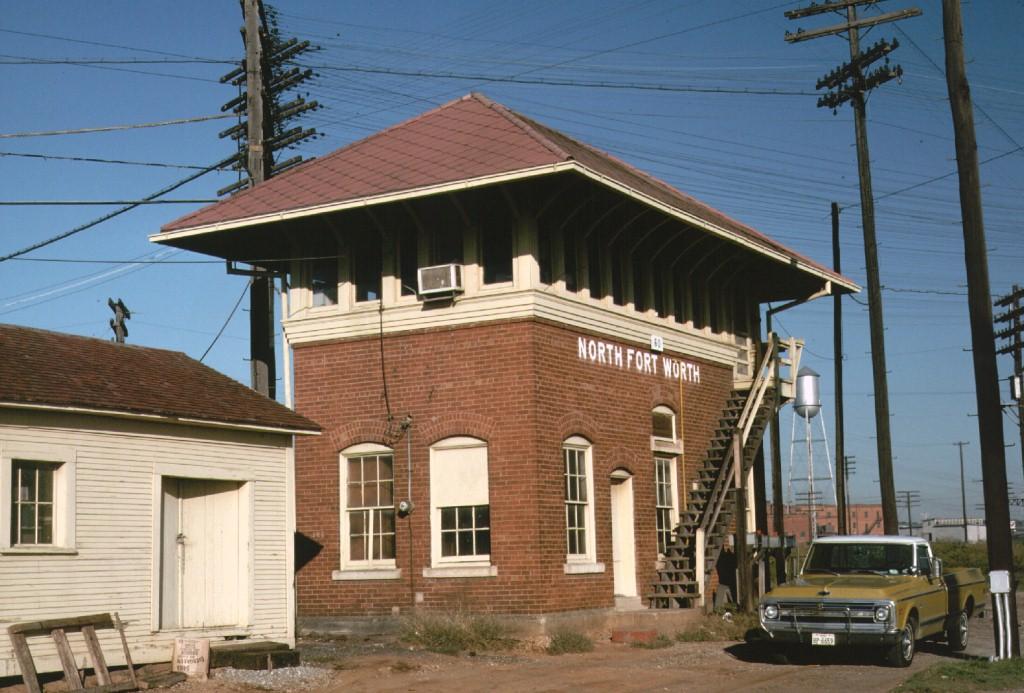
Above: When Tower 60 was
commissioned in 1905, it was probably not this building. Photographed by Gary
Morris in October, 1976, it
doesn't look seventy years old, but more significantly, its brick construction
would be substantially out of character for Santa Fe, the railroad that built
it. Other large towers built in Texas by Santa Fe used wood construction, e.g.
compare Tower 57, which opened in downtown Dallas
eight months before Tower 60, and Tower 19, which
opened two years earlier in south Dallas. Unfortunately, definitive
proof of what, if anything, may have preceded this structure (and if so, where,
precisely, it was
located) is lacking.
Tower 60 was identified by the Railroad Commission of Texas as "North Fort Worth", the town in which it was located.
The town didn't last long, but the tower's identity remained unchanged for the
duration of its existence.
Below:
Annotations on this 1889 topographic map of Tarrant County show the (future)
locations of Tower 18 and Tower 60, approximately four miles apart. Although the
roads on the map suggest a semi-rural area, the towers were only about 3 - 4 miles
north of downtown Fort Worth. Four railroads had laid
tracks into the area: the Fort Worth & Denver City (FW&DC) Railway; the Gulf,
Colorado & Santa Fe (GC&SF) Railway; the St. Louis, Arkansas & Texas (SLA&T, "Cotton
Belt") Railway; and the "Joint Track" built by the Texas & Pacific Railway that
was shared with the Missouri, Kansas & Texas Railway under a long term rights agreement. When Tower 18 was commissioned in
1903, the annual interlocker summary report published by the Railroad Commission
of Texas
identified its location as "Joint Track". Its identity changed to
"North Fort Worth" in the report published at the end of 1923, and it was
re-identified as "North Fort Worth (Hodge)" at the end of 1927.
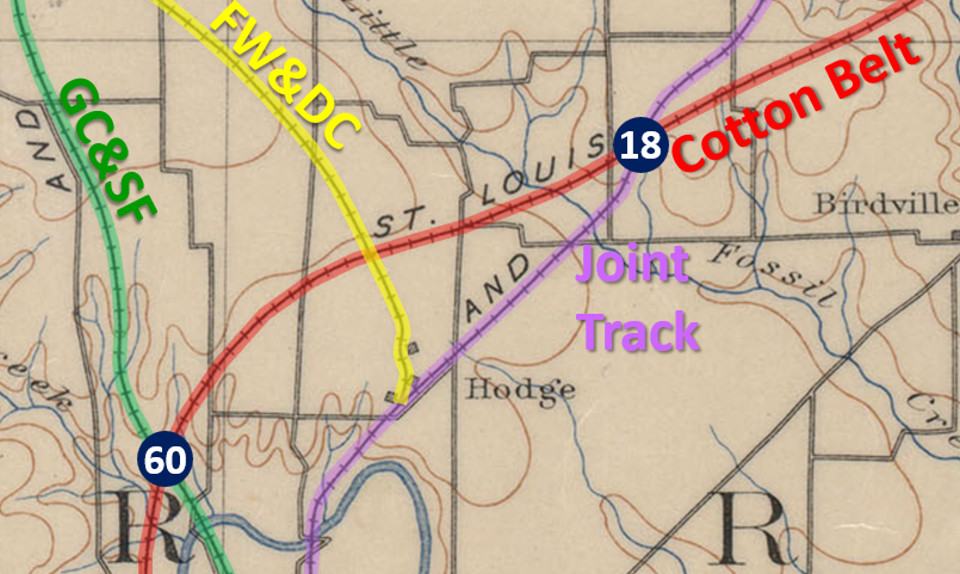
The origin of the name "Hodge" applied to an area
near the stockyards in north Fort Worth has not been determined. The earliest
newspaper reference found so far is from the Fort
Worth Daily Gazette of September 24, 1883 where Hodge is mentioned as a
locale "...about four miles north of this city.", a statement
made in the context of a community where someone lived. At the end of 1927, the Railroad Commission of Texas (RCT) reported Tower 18's
location as "North Fort Worth (Hodge)" even though Tower 18 was more than two miles away
from both of the places that traditionally had been referenced as "Hodge" by the
railroads. The first of those was
a switch on the Joint Track where the Fort
Worth & Denver City (FW&DC) Railway began building north toward Wichita Falls
on November 27, 1881. (In 1951, "City" was dropped, becoming simply the "FW&D".) At some point, the switch became known as "Hodge Junction",
but whether the general area was already referenced
as "Hodge" when construction began is undetermined. The other "Hodge" was about
a mile north of Hodge Junction
where tracks of the St. Louis, Arkansas & Texas (SLA&T, "Cotton Belt")
were built across the FW&DC in 1888. Northeast of both Hodge and Hodge Junction,
Tower 18 opened in 1903 where the Cotton
Belt crossed the Joint Track.
The first railroad to reach the future site of Tower 18 was the
Texas & Pacific (T&P) Railway, building from
Sherman to Fort Worth in 1881. By then, the T&P was controlled by rail magnate Jay Gould, who had established a
syndicate to purchase the stock of T&P President Thomas Scott for $3.5
million. Gould had formed a construction
company which the T&P had hired to build the remainder of the railroad to
El Paso and beyond. The T&P's effort to build a
transcontinental rail line from Texarkana to San Diego had begun in 1873 when
construction started on two parallel main lines west from Texarkana. The
northern route went via Paris to Sherman, 154 miles; the southern route went south to Marshall and then
west to Fort Worth, 248 miles. At those endpoints,
construction on both lines stopped in 1876, impacted by the
Panic of
1873 which had dried up railroad financing. Gould took over the T&P and
restarted construction in 1879 -- his syndicate would build the line from Fort
Worth to El Paso
in exchange for $20,000 in T&P stocks and $20,000 in T&P bonds for each mile
completed. As construction proceeded, Gould progressively gained financial
control of the T&P and was named President in April, 1881.
The T&P's track construction never reached El Paso, stopping instead at Sierra
Blanca where a deal between Gould and Southern Pacific (SP) Chairman C. P.
Huntington resulted in the T&P sharing SP's track into El Paso.
Towns on the T&P's northern route needed to be able to reach the line to El Paso, so Gould
laid tracks between Sherman and Fort Worth. He
elected to route due west from Sherman to Whitesboro and then proceed southwest to Fort Worth. In isolation, this would have been an odd
routing, but it was chosen to allow the Missouri, Kansas & Texas (MK&T, "Katy")
Railway to reach Fort Worth over the T&P's tracks.
Gould had become President of the Katy in 1879, and the
Katy already had a line from Denison to
Gainesville that passed through Whitesboro. With the T&P and MK&T both under Gould's control, the two
railroads signed a long term rights agreement to share the so-named Joint Track
between Whitesboro and Fort Worth. General Grenville M. Dodge had been on the
T&P's Board of Directors from the beginning, and with Gould's ascension, Dodge
had resumed his role as the T&P's Chief Engineer. Dodge was famous as the Chief Engineer for Union Pacific (UP) responsible for
the construction of the eastern part of the Transcontinental Railroad, completed
in 1869.
Gen. Dodge had spent significant time in Fort Worth over several
years and he was familiar with its numerous rail projects,
one of which was the FW&DC. It had been chartered on June 6, 1873 with a plan to
build through the Texas Panhandle to meet Colorado & Southern (C&S) rails coming
south from Denver. The Panic of 1873 along with other financial and
organizational obstacles had prevented the start of construction, hence the
stockholders were receptive when Dodge offered to build the FW&DC under the same stock and bonds arrangement Gould had used for the T&P
(and likewise, Dodge eventually became President of the FW&DC.) As this was
the FW&DC's initial construction, it did not
yet have tracks into downtown Fort Worth, and obtaining a right-of-way
would be time-consuming and expensive (Fort Worth already had 6,000 residents.) Instead, Dodge elected to use the Joint
Track as a means for FW&DC trains to reach downtown passenger facilities.
[Presumably Dodge had no difficulty negotiating the agreement to use the Joint Track;
he was still the T&P's Chief Engineer!]
Dodge chose a location on the Joint Track
about a mile and a half north
of the Trinity River to be the starting point for the FW&DC's construction
which commenced in
November, 1881. Whether the "Hodge" name had been applied to this area by then
is undetermined, but the location became known as "Hodge Junction". Dodge made
rapid progress; FW&DC trains were operating forty miles to Decatur by May, 1882.
The initial construction segment, 110 miles to Wichita Falls, was completed in
September, 1882. By April, 1888, the connection with the C&S had been
accomplished and trains were operating between Denver and Fort Worth. Just over a
mile north of Hodge Junction, the FW&DC built a freight yard that eventually was known as "North Yard."
By 1910, the FW&DC was owned by the C&S but continued to operate independently.
Below: The Fort Worth Daily Gazette of
June 4, 1887 quoted a recent news item from the Texarkana Times
announcing a contract to build an extension of the SLA&T west to Fort
Worth. The construction would be completed in less than a year.
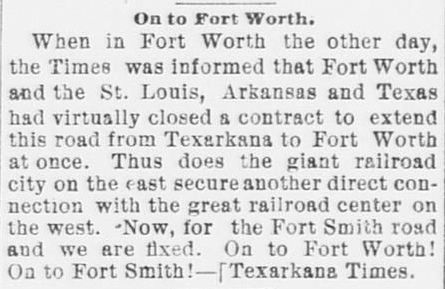
|
In 1887, the SLA&T began building a branch line
west from Mt. Pleasant, a town between Texarkana and
Big Sandy on the main line that had been built in 1880 by
the Texas & St. Louis (T&SL) Railway. At Commerce, 57 miles west of Mt. Pleasant, the line split into two branches, one
of which went
to Sherman via Wolfe City and Whitewright (much of the right-of-way is
now Texas Highway 11)
The other branch went to
Greenville and Plano,
passed north of Dallas (where a spur was
later built into downtown), and continued west through
Carrollton. Entering Tarrant County, it
turned southwest toward Fort Worth, crossing the Joint Track
at the future site of Tower 18. A couple of miles farther west, the SLA&T crossed the FW&DC.
A rail yard known as "Hodge" was built at the crossing, which was just
under a mile north of Hodge
Junction.
Right:
The Fort Worth Daily Gazette of
April 3, 1888 reported the arrival of the SLA&T into Fort Worth. Although
"Cotton Belt" became synonymous with the SLA&T's 1891
successor, the St. Louis Southwestern Railway, this news item shows that
the moniker had long been adopted by the SLA&T, inherited from its predecessor,
the T&SL. The newspaper greeted "the
World" on behalf of Fort Worth, but did any "Dwellers Thereof" accept the invitation to visit? |
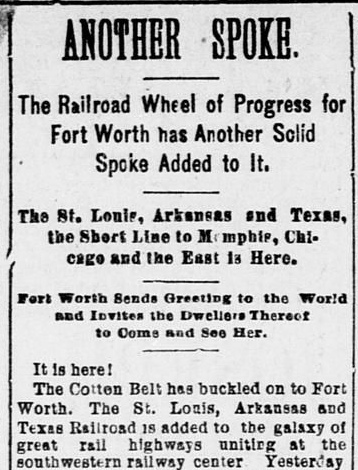 |
Well prior to the SLA&T's construction into Fort Worth, Jay Gould
viewed the Cotton Belt as a threat to his
business. Gould had assembled a rail network under his Missouri Pacific (MP)
enterprise that operated into Texas from St. Louis via gateways at Texarkana and Denison,
and he had leased both the T&P and the Katy to MP as part of this effort. In direct competition
to MP, the T&SL had expanded rapidly. By 1883, it was operating from Bird's Point,
Missouri on the Mississippi River to Waco and
Gatesville via
Texarkana. This expansion overextended the T&SL, largely because it
lacked the passing sidings and rolling stock necessary to run a lengthy, single-track railroad efficiently.
Although the T&SL entered receivership in 1884,
doing so helped keep the railroad from falling
into Gould's hands.
In February, 1886, the SLA&T was created by the
bankruptcy judge to become the new Cotton Belt, going against the advice of its
President, Sam Fordyce, who believed there were operational issues that would
inhibit profitability. Despite Fordyce's concerns, the receivership ended and within a year, the SLA&T
had decided to build the
new branch lines into north Texas hoping to compete with Gould on traffic from
Sherman and Fort Worth. This culminated in a secret agreement between Fordyce
and Gould
in 1888 for the Cotton Belt and MP to cooperate on traffic through Texarkana.
Through loans and stock purchases, Gould gained financial leverage over the
SLA&T, positioning him to guide its reorganization when it became insolvent in 1889. The new company created in 1891 was called the St. Louis Southwestern Railway
(SLSW or SSW, but always the "Cotton Belt", which Gould had wanted as its official name.) It was
headed by Gould's younger son, Edwin, who
remained the Cotton Belt's President until he retired in 1925. Subsequently, a series of ownership
changes resulted in the Cotton Belt becoming a subsidiary of SP in 1932.
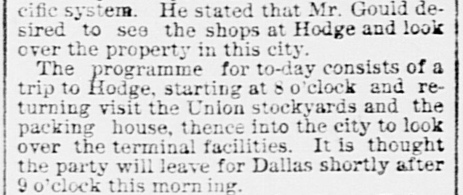 |
Left: Jay Gould visited Fort Worth in April,
1891 to view the stockyards and the Cotton Belt shops at Hodge. He died
from tuberculosis in New York in December, 1892. (Fort
Worth Gazette, April 11, 1891)
Right: Hodge was never
incorporated, but the residents viewed it as "a railroad town", in this
case, voting on who should receive a scholarship offered by the
newspaper. Note that a "Joint Agent" served both railroads, apparently
sharing a "transfer station" at Hodge. (Fort Worth
Gazette, July 18, 1891) |
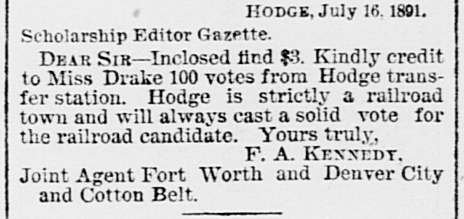 |
The SLA&T's April, 1888 arrival into Hodge included
track-laying a couple of miles farther west to the
stockyards where cattle shipping had become a major source of traffic. To avoid the time and expense of obtaining a right-of-way to reach downtown
passenger stations, the Cotton Belt had two choices: negotiate an agreement with the GC&SF
for the use of their track from the stockyards, or use the Joint Track,
as the FW&DC had done. Presumably, Gould and Fordyce were already having the
discussions that would lead to their secret agreement, so it is unsurprising that the
Cotton Belt chose the Joint Track -- the Cotton Belt's use of T&P's
passenger station may have been part of the agreement. There were two ways for
the Cotton Belt to
access the Joint
Track: use the FW&DC track between Hodge and Hodge
Junction, or connect to the Joint Track at their mutual crossing, the
future site of Tower 18. Both routes appear to have been used at varying times,
and at least by 1913 (and probably much earlier), a connecting track was in place at Tower 18 to support Cotton Belt access to the Joint Track.
A 1913 SLSW
employee timetable (ETT) states: "S.L.S.W trains
occupying track between S.L.S.W. Crossing and T. &. P. Passenger Station at Ft.
Worth will be governed by rules and time table of the M. K. & T. and T. & P.
Joint Track." If it seems odd that the Cotton Belt ETT's name for the Tower 18
crossing was the
self-referential "S. L. S. W. Crossing", it served to make these
instructions consistent with the name used by the Joint Track ETT under
which trains operated to reach downtown.
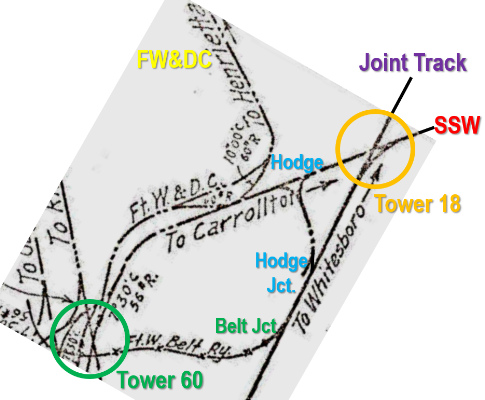 |
Left:
This snippet of a 1915 MK&T track chart (courtesy, Ed Chambers) has been
annotated and re-oriented so that North is up. The track diagram (not
drawn to scale) shows both routes for Cotton Belt passenger trains to
access the Joint Track: a connection in the southeast quadrant of
Tower 18, and the track between Hodge and
Hodge Junction. The "Ft. W. & D. C." label along the north track west of
Hodge shows where the FW&DC had built its own line into downtown c.1890
by curving through the northwest quadrant at Hodge and proceeding downtown via Tower 60. The track chart does not show a Cotton Belt /
FW&DC crossing at Hodge; the date this diamond was eliminated is undetermined, but it was likely soon after the FW&DC built its
line into downtown. After that time, there would have been little need
for the FW&DC to operate between North Yard and Hodge Junction. The
track between Hodge and Hodge Junction remained intact and appears to
have been used by the Joint Track railroads as a convenient means for
exchanging freight with the FW&DC and Cotton Belt. Note also the
"Ft. W. Belt Ry." label, identifying the Fort Worth Belt Railway that
connected to the Joint Track at Belt Junction.

Above: With an
unfortunate reference to "joint track" that was
not the T&P/MK&T Joint Track, this 1927
Cotton Belt ETT explains that trains will share FW&DC and GC&SF tracks
south of "Tower" (Tower 60) to access the GC&SF Passenger Station
downtown. Previously, the T&P Passenger Station had been used, as noted
in the aforementioned 1913 Cotton Belt ETT. Precisely when the station change occurred is undetermined,
but a good guess might be the period under the supervision of the U. S.
Railroad Administration during World War I. |
The lifespan of the Joint Track connector at
Tower 18 is unknown, but it seems likely that it was retained after
the Cotton Belt shifted passenger operations to the Santa Fe station. The
connector provided an alternate route
into downtown Fort Worth for Cotton Belt passenger trains seeking to avoid
congestion at Hodge Yard or Tower 60. The connector does not, however,
appear on a 1952 aerial image. Unfortunately, neither Tower 18 nor Tower 60 are
covered by Sanborn Fire Insurance maps of the era.
In 2004, Chuck Harris provided
his recollections of Hodge:
Glad to help out with the SSW/T&P-MK&T crossing near
Hodge. The place was called Swestern on the Cotton Belt. It wasn't
very far from the SSW yard office at Hodge and the T&P-MKT
yard office at Hodge. The two railroads were about a mile or so
apart and made a gradual slant toward each other before crossing.
You could see the crossing of the two railroads from North Sylvania
Ave grade crossing which was at the east end of the SSW yard.
I would say a mile or so. Yes, there was a tower there, but probably
gone by 1925 or 26. A 1916 dispatcher's train sheet for the SSW
shows a telegraph call for that location which would indicate
it was occupied.
Chuck refers to the "T&P-MKT yard office at Hodge" which
would indicate that the Joint Track railroads took over the former
FW&DC track segment between Hodge Jct. and Hodge. This probably
occurred in 1891; the track was no longer needed by the FW&DC, and with
both the Cotton Belt and the T&P under Gould's control, it would make
sense to share the yard. [MP's lease of the Katy was voided by court
order in 1891, but the Joint Track agreement remained in place,
and the Katy would also have wanted access to the yard at Hodge.] The 1915 track chart
shows connections in both directions at Hodge, but in only one direction
at Hodge Junction.
Right: In
this 1952 aerial view of Hodge Junction ((c)historicaerials.com), the
Joint Track slants across the right side of the image at a 45-degree
angle. The original location of the FW&DC switch on the Joint Track is
at the bottom of the image, with the track to Hodge curving up and to the
left. Across the triangle from the switch, a right-of-way is plainly
visible, perhaps with its track still intact. This connector was added
at some point to permit southbound Joint Track movements to go north to
Hodge, or vice versa. It also gave the Joint Track railroads a wye.
Although the right-of-way -- and perhaps the track -- for this connector
survived long enough to be visible in this 1952 image, the
connector right-of-way does not appear on 1956 imagery.
Although Hodge Junction did
not develop an extensive yard, the image shows spur tracks adjacent to
the Joint Track main line. Whether these were used for a general purpose
or a specific business is undetermined. The rail yard a mile north at Hodge evolved and expanded over
the years, adding yard tracks and connectors to facilitate traffic exchange among the Cotton
Belt, the Joint Track railroads and the FW&DC. |
 |
Gould owned a controlling interest in
the T&P, but he had very little ownership in the Katy, having been elected President through the efforts of his henchmen who had infiltrated the Katy's
executive ranks over several years. This left Gould vulnerable to the will of
the Katy's stockholders, and they had become very unhappy with the lopsided lease
terms that Gould had imposed on the Katy, essentially draining Katy profits
directly into MP's bottom line. Gould was fired from his position as Katy
President during a stockholders' meeting in May, 1888. By then, extensive legal
proceedings against the Katy were already underway by the Texas Attorney General. More legal proceedings ensued when the new management of the Katy
sought bankruptcy protection after firing Gould. [A major issue in all of
this legal wrangling was the disposition of the International & Great Northern,
Texas' largest railroad, which Gould had acquired and leased to the Katy -- a
story best told elsewhere.] In 1891, a court order
canceled MP's lease of the Katy, making it
independent, no longer legally or financially tied to Gould. Gould
died in late 1892, and his empire was taken over
by his son George, who remained President of the T&P until 1917.
Tower 18 was commissioned on July 25, 1903; at the time, the T&P and Cotton Belt were both headed by sons of Jay Gould,
George and Edwin, respectively. The crossing was at an acute angle, and the
tower was located in the obtuse southeast quadrant of the diamond. RCT's 1903 Annual Report
lists a
12-function / 12-lever Union Switch & Signal mechanical interlocker. Twelve functions was the minimum standard configuration for a
crossing of two railroads, consisting of a home signal, distant signal and derail
in each of the four directions. RCT documentation shows that the tower was operated by
T&P personnel which suggests that the tower had been built by the T&P.
The crossing existed before 1901, so RCT
regulations required the two railroads to split the capital cost of the tower and interlocking plant evenly. In this particular case, the recurring
operations and maintenance (O&M) expenses would also have been split evenly
because each railroad used half of the twelve functions. Although the Katy sent
substantial
traffic through Tower 18, RCT did not show it officially obligated for a share of O&M expenses because the Joint Track
was formally owned by the T&P. The T&P's share of recurring expenses would have been
split with the Katy under their trackage rights agreement.
Tower 18's
function count was unchanged from 1903 through 1929, but RCT's
interlocker table dated
December 31, 1930 (the last such table to be published) reported the function count reduced to eight and the interlocking plant converted to automatic. Most likely, the four functions eliminated were
the derails in each direction. Experience across the country had shown
that derails created more problems than
they solved when used as protection for crossing diamonds (they remained
valuable to prevent unplanned movements of railcars from industry spurs and yard tracks.) On March 31, 1930, RCT held a hearing to discuss two automatic
interlockers without derails that the FW&DC had proposed for
Lubbock and
Plainview. The proposal was accepted by RCT on May 1, 1930, hence
Tower 141
(Lubbock) and Tower 142 (Plainview) were the first
towers to get initial commissioning by RCT as
automatic interlockers. They were installed in
February and March, 1931, respectively, dates that somehow managed to be reported in a table dated December 1, 1930! That same table lists two other
interlockers as automatic: Tower 11 (West Orange) and Tower 18, both of
which had been listed as mechanical in the prior year's table. A letter
in the RCT interlocker archives at DeGolyer Library, Southern
Methodist University, states that Tower 11's conversion was actually completed
in June, 1931. The precise date of
Tower 18's conversion has not been determined, but it's possible that it was the
first operational automatic interlocker in Texas.

Above: The stockyards had evolved from a cattle shipping
location in the late 1880s to become a cattle processing and meat-packing center
by the mid 1890s. In 1895, the
Fort Worth Stockyards and Belt Railway was chartered to provide switching
services for the stockyards and associated processing plants. The following
year, "Stockyards" was dropped from the railroad's name, becoming simply the
Fort Worth Belt (FWB) Railway. By 1902, large processing and packing facilities
had been built by Armour and Swift, two national meat companies. This map of the
vicinity of Tower 60 was published by the Interstate Commerce Commission in its
1918 valuation report for the FWB, which connected with the Tower 60 railroads
and to the Joint Track railroads via Belt Junction. Frisco Jct. was where
the Cotton Belt intersected the St. Louis & San Francisco ("Frisco") Railway,
which had its major yard in south Fort Worth. For several years, Frisco operated
between Carrollton and Frisco Jct. using Cotton Belt trackage rights. The town of Niles City (light pink)
represented yet another attempt to incorporate the area around the stockyards to
prevent encroachment by the growing city of Fort Worth.
Less than two miles west of Hodge,
multiple railroads passed through an area adjacent to the Fort Worth Stockyards
that would eventually become the site of Tower 60.
The first was the GC&SF, laying tracks north from Fort Worth in 1886 toward
Purcell, Indian Territory (Oklahoma) where it would meet a construction crew of
the Atchison, Topeka & Santa Fe (AT&SF) building south from Kansas. The
connection of the two railroads was part of an agreement under which the
GC&SF would become a wholly-owned subsidiary of the AT&SF in 1887. The GC&SF had
been looking for ways to stimulate out-of-state import/export traffic through
the Port of
Galveston, the city where it was headquartered. At the
same time, the AT&SF was seeking an efficient export outlet for Midwest grain
and other agricultural
commodities. Becoming part of Santa Fe
strengthened the GC&SF, which grew to have a major presence in Texas railroading.

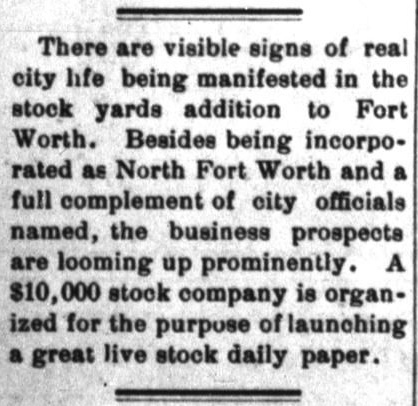 |
By the turn of the century, the
stockyards and meat-packing plants had grown to become a massive
economic engine for Fort Worth. To protect the area from taxation
by the City of Fort Worth, a new town was incorporated as North Fort
Worth in an election held in November, 1902. Reportedly, the vote was
170 - 1.
Left Top:
Dallas Southern Mercury, November
13, 1902
Left Bottom:
Mineral Wells Weekly Index,
November 14, 1902
Right: The new town
held its first municipal election in December, 1902 (Houston
Post, December 7, 1902)
State law allowed larger
cities to annex nearby incorporated areas of limited population. The
1909 Fort Worth City Charter officially abolished North Fort Worth and
took over its debts, but did not immediately incorporate the stockyards. In
February, 1911, a new town, Niles City, incorporated the stockyards
vicinity
with 508 residents. When a January, 1921 state law set a threshold of 2,000 residents
for towns to be able to prevent annexation, Niles City quickly expanded
its boundaries to reach that number. The Legislature responded six
months later by raising the threshold to 5,000 residents, and Niles City
soon met its demise, annexed by Fort Worth on August 1, 1923. |
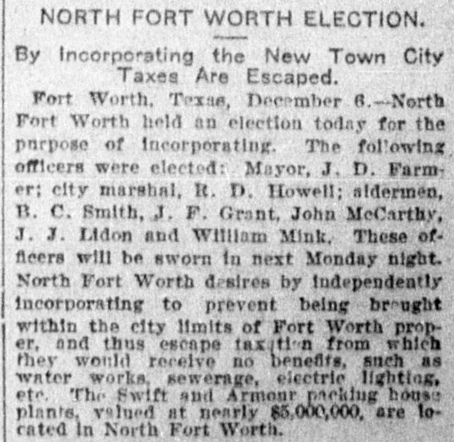 |
After the FW&DC had passed near the stockyards when
building its own line into downtown in 1890, the Chicago, Rock Island & Texas
(CRI&T) became the fourth railroad to enter the vicinity. The CRI&T was a
Texas-based subsidiary of the Chicago, Rock Island & Pacific (CRI&P), a major
Midwest railroad. The CRI&T had crossed the Red River into Texas near Ringgold
in 1892 and continued south, ostensibly heading toward Weatherford, a town on
the T&P's line west of Fort Worth. Having reached Bridgeport 32 miles shy of
Weatherford, Rock Island amended its charter and turned southeast to build to
Fort Worth. It arrived on August 1, 1893, passing
through Saginaw and the stockyards area en route to downtown. Ten years later, the CRI&P chartered the Chicago, Rock Island
and Gulf (CRI&G) to build from Fort Worth to Dallas and to absorb the CRI&T and
two other Texas-based subsidiaries of the CRI&P. State law required railroads
owning tracks in Texas to be headquartered in state, hence, the CRI&G was based
in Fort Worth and owned all of the CRI&P subsidiary tracks in Texas.
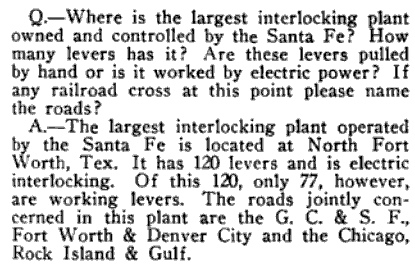
Rail service to the packing plants and the stockyards created a complex web of
tracks filled with switch engines plus main line freight and passenger trains
heading into and out of downtown Fort Worth. To manage this tangle of connecting tracks and
crossing diamonds, Tower 60 was commissioned by
RCT on July 1, 1905. The tower's location was identified as "North Fort Worth"
and its electrical interlocking plant had 83 functions, a huge number indicative of the complexity of the track
network. Among Texas interlocking plants, Tower 60's function
count was exceeded
only by the 122 functions in effect
at Tower 55 in downtown Fort Worth. Tower 60 would
fall to fourth place by the end of
1930, surpassed only by Tower
55, Tower 106 in Dallas and
Tower 26 in Houston.
Tower 60 was built by
Santa Fe, which was also responsible for staffing. Santa Fe shared the recurring
O&M expenses with the Cotton Belt, the FW&DC, the Rock Island and the Fort Worth
Belt on a "weighted function"
basis, i.e. the number of interlocking functions allocated to each individual railroad
compared to the total number of functions in the plant. Since all five railroads
had built through the area prior to 1901, the capital cost of the tower and its
interlocking plant would have been shared evenly among them.
Left:
a question in the Q&A column of a 1914 edition of Santa Fe
Magazine
 Another
railroad that operated through Tower 60 at various times was the St. Louis, San
Francisco & Texas, a subsidiary of the St. Louis & San Francisco ("Frisco")
Railway, a major Midwest railroad. In
the early 1900s, the Frisco and Rock
Island railroads were led jointly by B. F. Yoakum, a native Texan who had risen to
the top after executive stints with the San Antonio &
Aransas Pass Railway and the GC&SF. Yoakum was an expert in Texas
railroading, and he sought to expand the networks of the Frisco and Rock Island
in state. To compete against Santa Fe for livestock shipments from the vast
range southwest of Fort Worth, the Frisco purchased controlling interest in the Fort Worth & Rio Grande
(FW&RG) Railway in 1901. It had tracks from Brownwood to Fort Worth, a shorter,
direct line compared to Santa Fe's route from Brownwood via
Temple. The following year, a new Frisco
line entered Texas from Oklahoma. It shared the Katy's bridge over the Red
River, used SP trackage rights to reach Sherman, and then built a new line south to Carrollton. Yoakum negotiated trackage rights on
the Cotton Belt to allow Frisco trains to reach Fort Worth from Carrollton. The
connecting point in Fort Worth was Frisco Junction, about a half mile south of
Tower 60 where the Cotton Belt intersected a new 4.5-mile Frisco track that led
to a new yard in south Fort Worth that had been opened along the FW&RG main line.
Frisco Junction was very close to the stockyards, which Frisco served with
industry spurs.
Another
railroad that operated through Tower 60 at various times was the St. Louis, San
Francisco & Texas, a subsidiary of the St. Louis & San Francisco ("Frisco")
Railway, a major Midwest railroad. In
the early 1900s, the Frisco and Rock
Island railroads were led jointly by B. F. Yoakum, a native Texan who had risen to
the top after executive stints with the San Antonio &
Aransas Pass Railway and the GC&SF. Yoakum was an expert in Texas
railroading, and he sought to expand the networks of the Frisco and Rock Island
in state. To compete against Santa Fe for livestock shipments from the vast
range southwest of Fort Worth, the Frisco purchased controlling interest in the Fort Worth & Rio Grande
(FW&RG) Railway in 1901. It had tracks from Brownwood to Fort Worth, a shorter,
direct line compared to Santa Fe's route from Brownwood via
Temple. The following year, a new Frisco
line entered Texas from Oklahoma. It shared the Katy's bridge over the Red
River, used SP trackage rights to reach Sherman, and then built a new line south to Carrollton. Yoakum negotiated trackage rights on
the Cotton Belt to allow Frisco trains to reach Fort Worth from Carrollton. The
connecting point in Fort Worth was Frisco Junction, about a half mile south of
Tower 60 where the Cotton Belt intersected a new 4.5-mile Frisco track that led
to a new yard in south Fort Worth that had been opened along the FW&RG main line.
Frisco Junction was very close to the stockyards, which Frisco served with
industry spurs.
Above: RCT's 1907
Annual Report published at the end of the year listed Frisco's trackage rights,
all of which pertained to the line from the Red River to Fort Worth. All of
these rights had been in place since 1902.
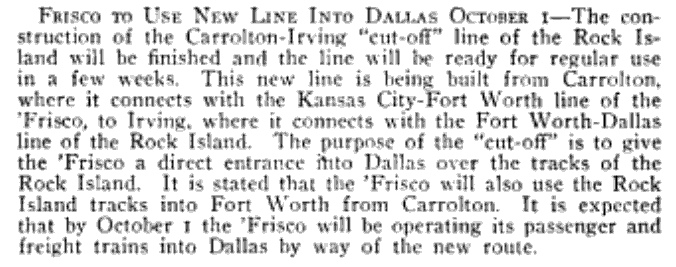 Yoakum's
strategic plan was to connect his Frisco and Rock Island operations in north
Texas with his Gulf Coast Lines network which was under development between New
Orleans and Brownsville. His next step was to have Rock Island
build a line from Fort Worth to Dallas; this was the genesis of the CRI&G
charter with a plan was to continue beyond
Dallas to reach the Gulf Coast Lines at
Houston. The track to
Dallas was laid in 1903, passing through Irving, eleven miles south
of Carrollton. After a four year delay, Rock Island built a "cut-off" between
Carrollton and Irving in late 1907 to allow Frisco trains at Carrollton to continue
south to Irving and proceed east to Dallas or west to Fort Worth on Rock
Island's tracks. This allowed Frisco to relinquish rights on the Cotton Belt from Carrollton to Frisco Junction.
Yoakum's
strategic plan was to connect his Frisco and Rock Island operations in north
Texas with his Gulf Coast Lines network which was under development between New
Orleans and Brownsville. His next step was to have Rock Island
build a line from Fort Worth to Dallas; this was the genesis of the CRI&G
charter with a plan was to continue beyond
Dallas to reach the Gulf Coast Lines at
Houston. The track to
Dallas was laid in 1903, passing through Irving, eleven miles south
of Carrollton. After a four year delay, Rock Island built a "cut-off" between
Carrollton and Irving in late 1907 to allow Frisco trains at Carrollton to continue
south to Irving and proceed east to Dallas or west to Fort Worth on Rock
Island's tracks. This allowed Frisco to relinquish rights on the Cotton Belt from Carrollton to Frisco Junction.
Right:
Railway World, August 23, 1907
Frisco trains entering Fort Worth from the east on Rock Island tracks curved
into downtown and connected into the T&P. This allowed trains to serve
passenger operations at the T&P Station, or proceed to the FW&RG tracks farther
west which led to the Frisco's freight yard. RCT's 1911 Annual Report lists Rock Island
with 0.36 miles of trackage rights on the T&P to effect this connection.
In 1937, Frisco sold the FW&RG to Santa Fe, but
retained the tracks going north from their main yard in south Fort Worth to
Frisco Junction. This allowed them to continue serving the stockyards. They also
retained the line between the yard and the T&P connection to facilitate
continued access via Rock Island's line from Irving. Although the line to Frisco
Junction crossed the T&P, it was not at grade and there were no connecting
tracks, hence the track between the yard and the T&P connection was critical.
At some undetermined date, this track was abandoned, leaving the line
to Frisco Junction as the only means for trains to reach Frisco's yard. Frisco
trains from Irving would enter
Fort Worth near downtown, but there was no direct route to the Frisco yard. Going north to Tower 60 was not a solution because
there was no simple way to turn the train around to go back south to Frisco Junction.
To solve this problem, a connecting track between the Rock Island and Cotton Belt
tracks was built south of Tower 60, barely north of their respective rail
bridges over the West Fork of the Trinity River. This required the Frisco to
obtain Cotton Belt rights over a short section of track.
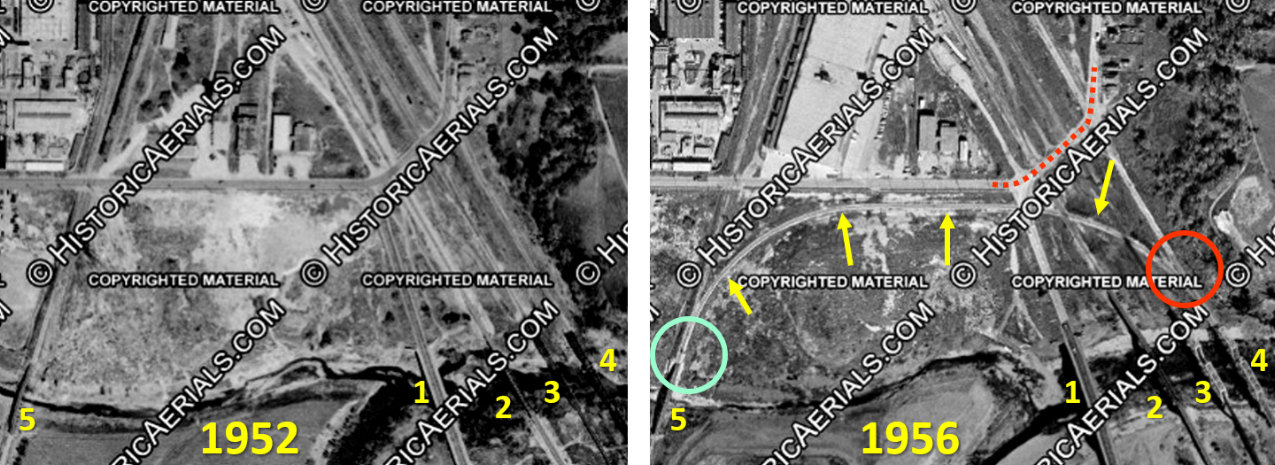
Below: In these two
north-facing aerial images ((c)historicaerials.com), the first four numbered
bridges, all of which cross the West Fork of the Trinity River, are: (1) Samuels
Ave. street bridge; (2) GC&SF rail bridge; (3) FW&D rail bridge; and (4) Rock
Island rail bridge. Bridge (5) is the Cotton Belt rail bridge over Marine Creek.
The rail connector (yellow arrows) that was added between 1952 and 1956 provided
a connection between the Cotton Belt track (green circle) and the Rock Island
(red circle). Frisco Junction was located about 700 ft. south of the Cotton Belt
bridge (5). Due to its proximity, Tower 60 would most likely have managed the
signals and switches for this connecting track. The red-dashed roadway is NE
23rd St. / Decatur Ave. which crossed the three main tracks at grade.
Below: Lines in the Samuels Ave. pavement mark its grade
crossing of the former Frisco connecting track; it was removed sometime between
1981 and 1990. Note also the swing gate to the right.
The switch off the Cotton Belt remains intact, but the track now ends inside the
fenced yard of the unidentified business to the right. (Google Street View 2013)

Below: The brick Tower
60 was razed
in the 1980s. (undated photo, Museum of the American
Railroad collection)
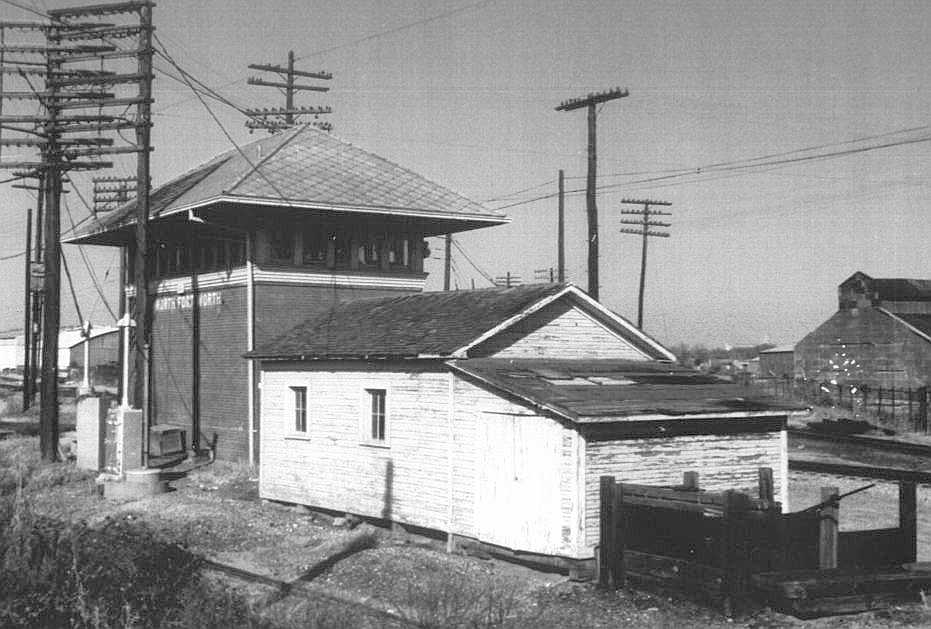 |
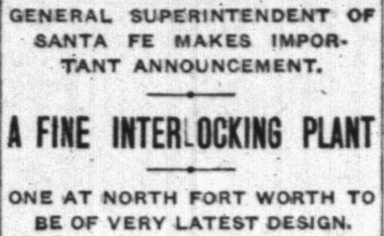
Fort Worth Record & Register,
February 8, 1904
Who wouldn't want to see a "monster interlocking plant"?
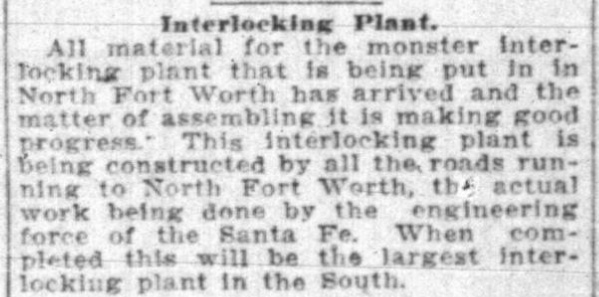
Fort Worth Record & Register,
September 2, 1904
|
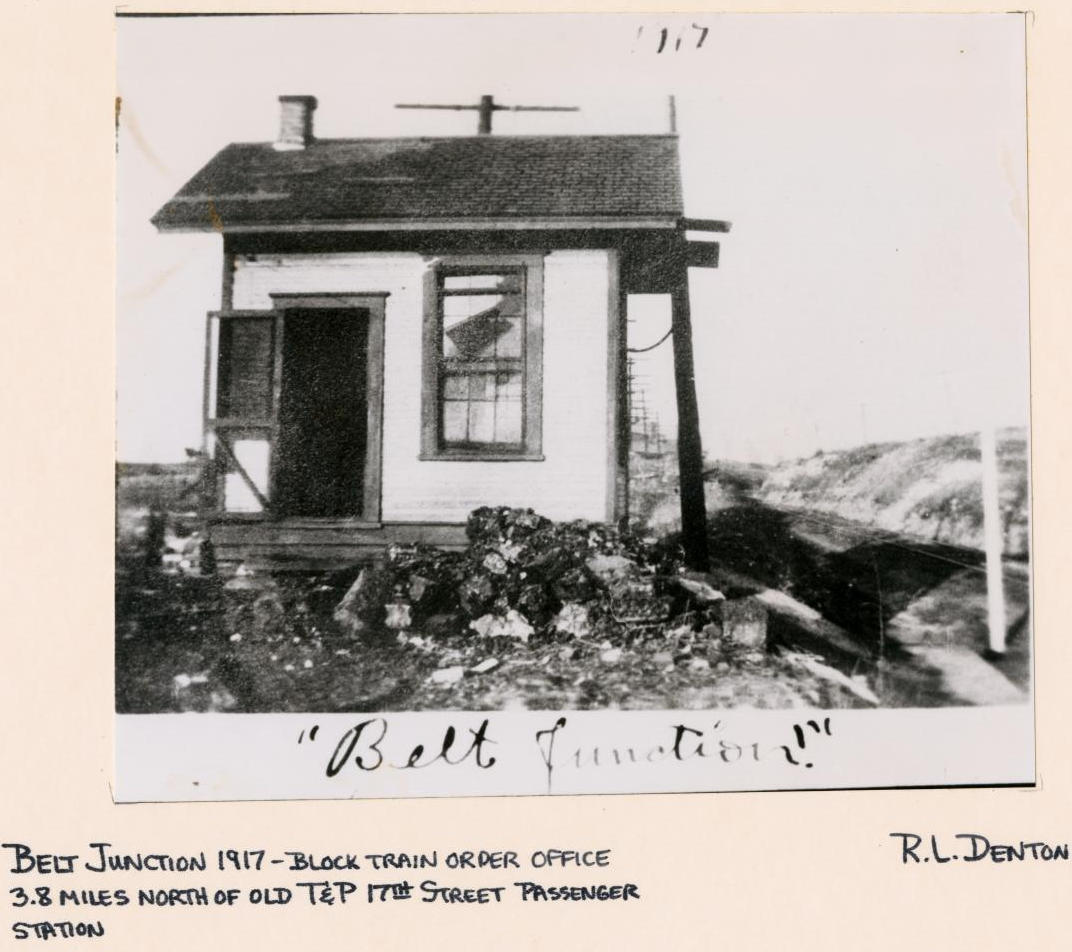 |
Left:
A train order office, presumably operated by the Fort Worth Belt, was
located at Belt Junction. (1917 photograph by R. L. Denton, courtesy the Grace
Museum, Cleburne, and The Portal to Texas History, hat tip, Dennis Hogan)
Right: These passages are excerpted from the June
6, 1925 issue of
Railway Review which published a
paper presented in March of that year by Santa Fe Signal Engineer, E. Hanson, at a Chicago gathering of the Signal Section of the American
Railway Association. The paper was titled Train Operation By Signal
Indication Only, describing a comprehensive control system that had
been installed
by Santa Fe between downtown Fort Worth and Saginaw, a distance of eight
miles. The control system allowed switch engines to operate without
train orders and was managed primarily by operators at Tower 60, near
the midpoint of the system. The paper notes "...an average of 1,000
train and engine movements per day..." through the Tower 60
interlocking. Wow! |
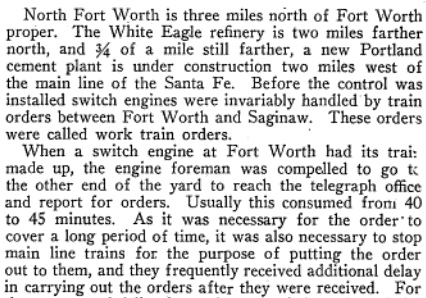
 |
At the end of 1923, RCT's annual report changed
Tower 18's location from Joint Track to "North Fort Worth"
which had always been the location listed for Tower 60. While this
change
could
indicate that the Tower 18 controls were
remoted to Tower 60, T&P's 1925 List of Stations reported a telegraph at "StLSW
crossing" implying that Tower 18 was still manned. RCT had been known to change
tower location identity (e.g. Tower 28, which
started out at "Sulphur" and successively became "South of Texarkana",
"Texarkana, 2 miles west" and "West of Texarkana"), but such
descriptive changes usually occurred relatively soon after initial commissioning. The incentive to
change
Tower 18's location twenty years after commissioning isn't apparent unless it pertained to
operations, but using "North Fort Worth" had the downside of potential confusion
with Tower 60. RCT's interlocker list published December 31, 1927 changed Tower 18's
location again, this time to "North Fort Worth (Hodge)". This could imply that the interlocker controls were relocated to an office at Hodge
Yard, as the name would otherwise appear inapplicable to a crossing two miles
distant from both of the places known to railroaders as "Hodge". Certainly Hodge
Yard needed close coordination with movements through Tower 18, but whether
this entailed remote control of the interlocker (a technology becoming more
widespread
in the 1920s, see Tower 25) has not been determined. If the
controls were remoted to Hodge Yard in 1927, the interlocking plant was
presumably moved to an equipment cabinet so the tower could be closed.
Undoubtedly it was closed by the time the new automatic
interlocking plant was installed in 1931. The timing of Tower 18's demise and
the ultimate disposition of its building remains undetermined,
and no photo of the tower has been found.
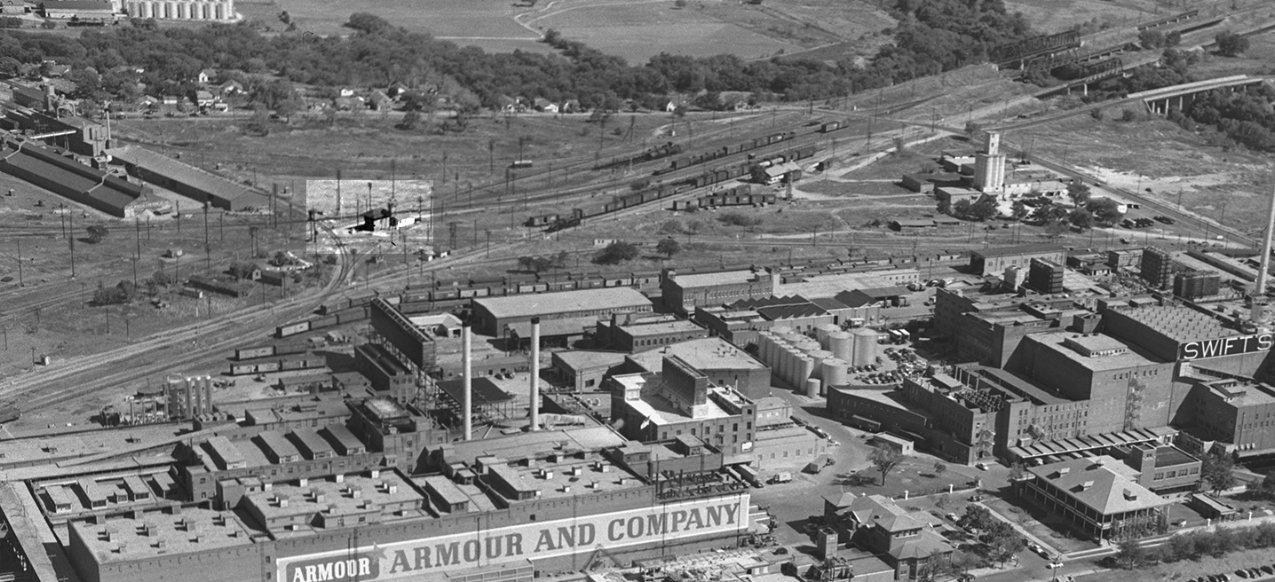
Above: In this snippet from an undated (~ 1930s/40s)
aerial view of the meat-packing plants facing southeast, Tower 60 is highlighted left of center.
While the illuminated side of the tower certainly appears brighter than the
darker brick in more recent photos, and the respective brightness levels of the
roof and the tower's long side show a substantial difference compared to later years, this
could be simply a function of the sun's position and the angle of the light
reflected to the camera. Without more, whether this was an
earlier version of Tower 60 can't be established. Also, note the linear offset of the tower with
respect to the (white) outbuilding beside it. The exact same offset appears in
the image below left. It seems implausible that the new
brick tower would have been built in precisely the same spot as an older one
given the need to maintain operations during construction. It also seems likely
that if there was a consensus that the original tower needed to be replaced, the
effort to do so would have occurred sooner than perhaps 40 years after it opened.
There are numerous historic aerial images of the stockyards area showing Tower
60. Unfortunately, none of the ones found thus far provide sufficient resolution
to convey an unmistakable glimpse of a tower that preceded the brick structure
of later years. While there is valid speculation that the brick building was not
the first Tower 60, evidence of a prior tower remains elusive. Note also
that the NE 23rd St. / Decatur Ave. roadway is visible crossing all three tracks
at grade at upper right. The four bridges (Samuels Ave. plus the three rail lines) over
the West Fork of the Trinity River are visible beyond the road crossing, and the
Frisco connecting track does not yet exist. (image courtesy Bennett.Partners)
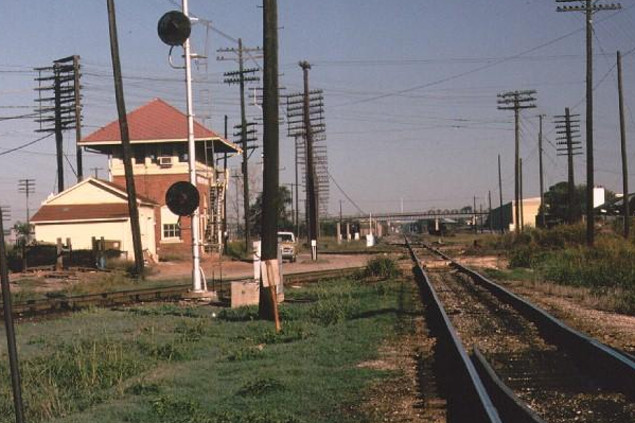
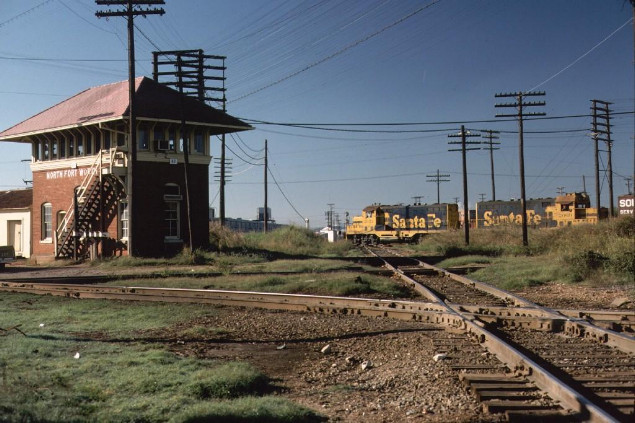
Above Left: This view looks northwest along the Rock
Island tracks passing beside the east face of Tower 60. The FW&DC crosses in the foreground
and the Fort Worth Belt is visible behind the tower. Above Right:
This southwest view down the Cotton Belt shows
southbound Santa Fe locomotives about to pass the west side of the tower. The near diamond is the Rock Island
crossing the Cotton Belt, and the Fort Worth Belt crosses the Cotton Belt just beyond it.
(both photos by Gary Morris, October, 1976)
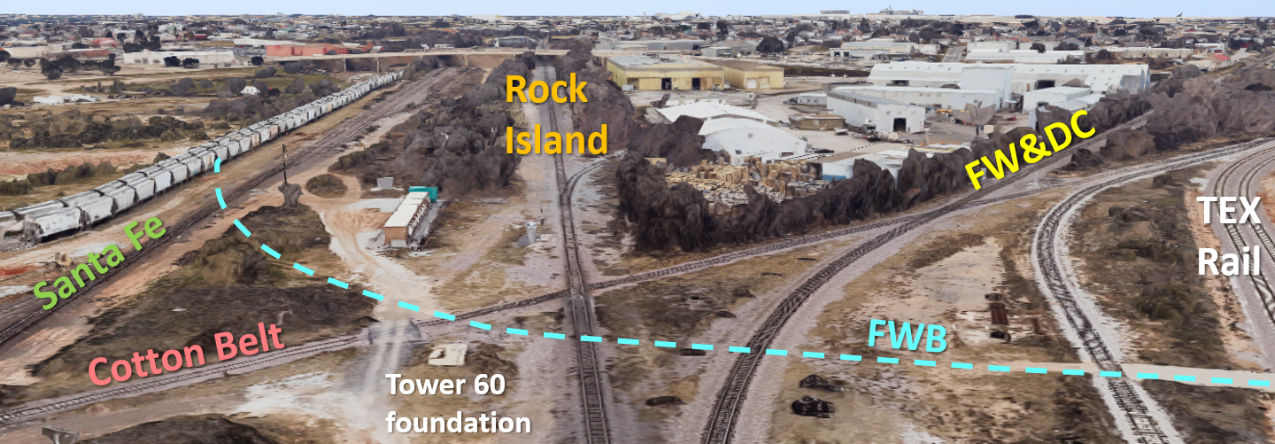
These recent Google Maps
simulated 3-D images of the Tower 60 junction have annotations showing the legacy
railroads.
Above: This view is northwest along
UP's ex-Rock Island right-of-way, similar to
the previous photo above left. Historic aerial images indicate that the "road" visible to
the left of the tower's foundation was originally a spur or connecting track. Aerial imagery shows that the Fort Worth Belt tracks were removed at
some undetermined time between 1981 and 2001.
Below: This image shows a southwest view along the former Cotton Belt tracks.

Majority ownership of the Fort Worth Belt was obtained
by the T&P in 1932, but the FWB continued to operate under its own name. In the
1970s, the FWB and T&P were merged into MP.
It had owned a majority share
of the T&P's stock since the 1930s, but did not effect control until 1976. MP
was acquired by UP in 1982 but it continued to operate under the MP name and it
proceeded to acquire and merge the Katy in 1988. SP had owned the Cotton Belt since 1932 and it
integrated the Cotton Belt operationally in 1992. In 1996, UP acquired SP and in
1997, all of its component railroads were integrated under the UP name.
In 1965,
the GC&SF was operationally merged into the parent AT&SF and the GC&SF name was
retired. In 1981, the C&S was merged into Burlington Northern (BN), taking with
it the FW&D, which ceased operations under that name. AT&SF and BN merged to
become Burlington Northern
Santa Fe (BNSF) in 1996.
The original track segment between Hodge Junction and Hodge remains in place with a few spurs into various trackside businesses.
It is owned and operated by
the Fort Worth & Western (FWW) Railroad, a Class III short-line railroad founded
in 1988 that also operates the yard at Hodge. Among various expansions, the FWW took
over operation of the former Cotton Belt line between Carrollton and Fort Worth.
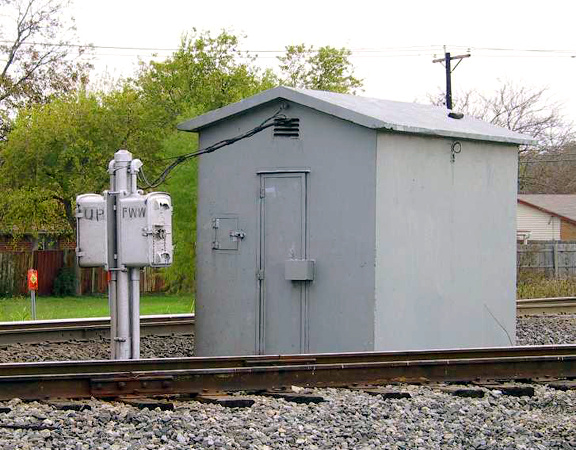
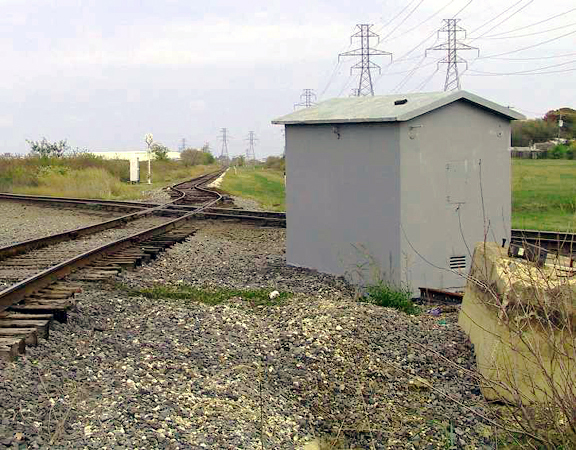
Above: In these photos taken c.2002, a walk-in hut
located within the acute angle southwest of the diamond houses the automatic interlocker
at the Tower 18 crossing. The post in
front of the door holds manual override controls for UP and FWW to allow train
crews to override the signals when necessary. The odd curves on the FWW
(ex-Cotton Belt) track near the diamond resulted from the use of a
replacement crossing diamond that did not have the proper angle. This was
subsequently corrected. (Jim King photos.)
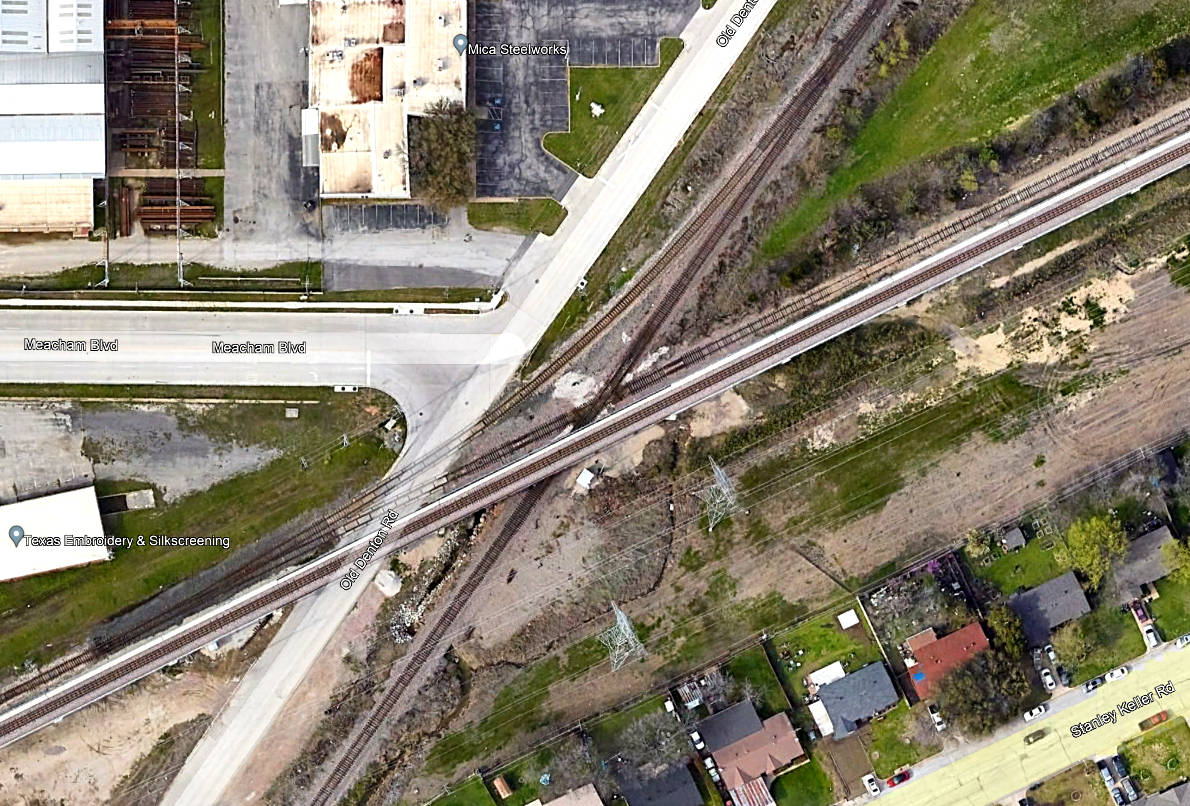
Above: This 2022 Google Earth image of the Tower 18
crossing shows a connecting track in the northwest quadrant. It also shows a
rail bridge passing over Old Denton Rd. and the former Joint Track.
TEXRail, a commuter rail system between downtown
Fort Worth and DFW airport, was constructed sharing portions of the former Cotton
Belt tracks and right-of-way. The FWW freight tracks are visible parallel to the
bridge, still crossing the former Joint Track (now UP) at grade. Just over a
mile to the east, the commuter and freight tracks merge into a single
ground-level track. Proceeding east to Grapevine and DFW Airport, they
periodically re-divide into separate commuter and freight tracks in the vicinity
of passenger stations. To the west, the commuter tracks remain isolated all the
way into downtown, and much of the right-of-way is grade-separated.
Kal Silverberg explains the
connecting track... (Sept. 22, 2004)
"Tower 18 now has a connection in place in the northwest quadrant so southbound
trains on the former T&P can go west on the former SSW through Hodge Yard. There
is a new track along the north side of Hodge Yard and it has CTC signals at the
east end of Hodge Yard (by Sylvania St. crossing) waiting to be turned on. The
new track ties into the former FW&D line just east of Deen Road. It is my
understanding that UP will run directionally between Towers 18 and 55."
Kal Silverberg discusses the commuter rail bridge... (June 4, 2020)
"TEXRail to DFW Airport from the T&P station in downtown Fort Worth began
operations in January, 2019. Construction probably started in 2017 so that's
when the bridge over Tower 18 went in. TEXRail is completely separated from the
railroad network from north of Tower 18 to the former 6th Street Jct. in Fort
Worth, with the exception of one crossover at the north (east) end of Hodge Yard
to enable equipment to get to and from the TEXRail maintenance base."
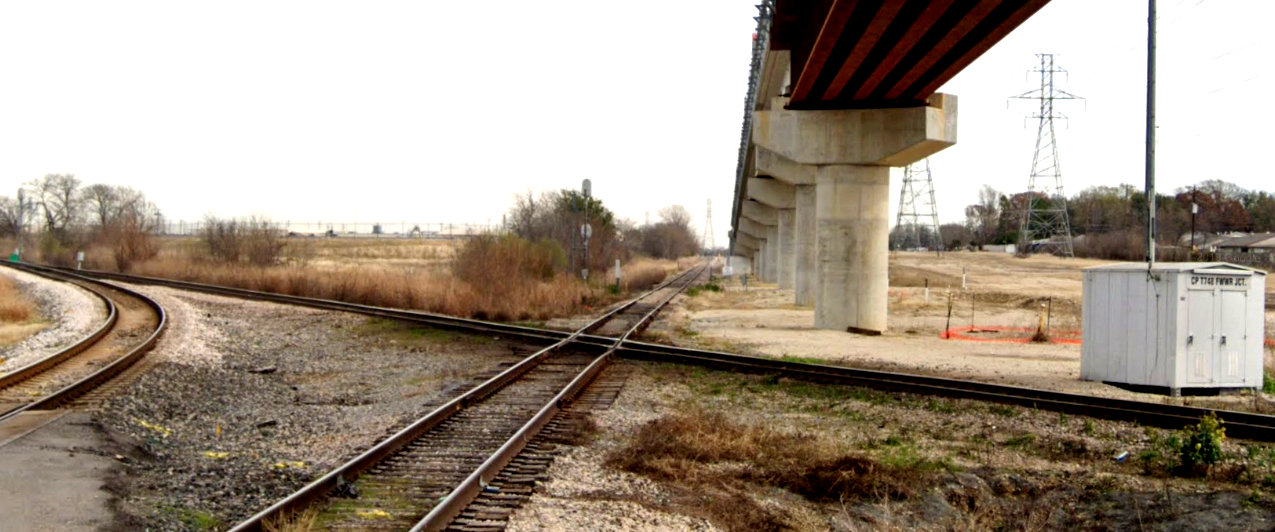
Above:
Facing east-northeast along the former Cotton Belt right-of-way, this February
2019 Google Street View shows the Tower 18 crossing site. The former
Joint Track, now a UP main line, crosses in the foreground, and UP's 2004 connector track in the northwest quadrant is
visible at far left.
Overhead, the TEXRail bridge provides grade separation for commuter rail trains
to/from DFW airport. The freight rails and the commuter rails join into a single
ground-level track just over a mile distant, but they periodically separate at
commuter stations as the line proceeds to DFW Airport.
Below:
This simulated Google Maps 3-D aerial view of Hodge Yard shows how the Cotton Belt would
have crossed the FW&DC main line
from Hodge Jct. prior to the FW&DC's construction of a separate line into downtown (curved line
at far left). Now, the
track coming up from Hodge Jct. splits into east and west connector tracks, the
west track showing a pair of UP locomotives. The blue arrows mark the elevated
line for TEXRail commuter trains which returns to ground level to pass beneath
Interstate 35.

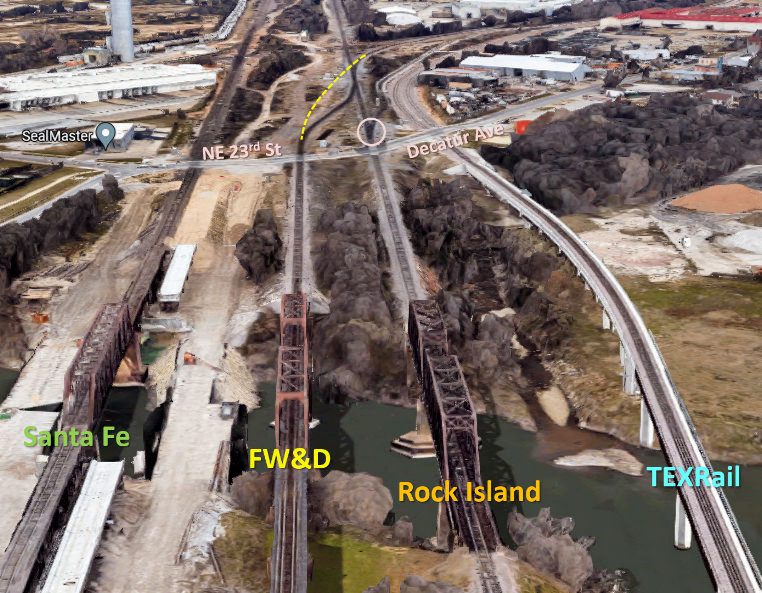 |
Left:
Looking north toward the former Tower 60 crossing, this Google Maps simulated 3-D image
shows that the traditional "Three Sisters" rail bridges over the West Fork of the Trinity River
have been joined by a fourth at far right carrying TEXRail commuter trains.
Where the FW&DC (now BNSF) previously curved northeast (yellow
dashes) to cross the Rock Island (now UP), the diamond has been removed,
replaced by two switches and a short track segment on the Rock Island.
Taking the north switch, the track immediately crosses over the Cotton
Belt (now FWW) with no connection. Instead, a switch (pink circle) off
the Rock Island just beyond the Decatur Ave. grade crossing leads to the Cotton Belt tracks,
which proceed northeast into Hodge. Although the Cotton Belt and FW&DC
tracks are generally parallel between Tower 60 and Hodge, there is no crossover
between them until reaching the west end of the yard.
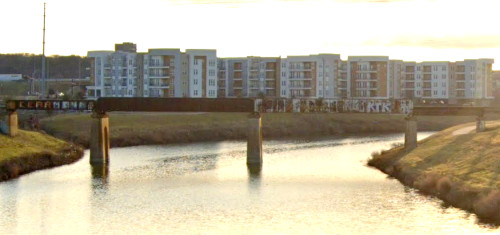
Above: The former
Joint Track (now UP) bridge over the West Fork of the Trinity River is
0.6 miles east of the "Three Sisters".
(Google Street View, January, 2023) |














 Another
railroad that operated through Tower 60 at various times was the St. Louis, San
Francisco & Texas, a subsidiary of the St. Louis & San Francisco ("Frisco")
Railway, a major Midwest railroad. In
the early 1900s, the Frisco and Rock
Island railroads were led jointly by B. F. Yoakum, a native Texan who had risen to
the top after executive stints with the San Antonio &
Aransas Pass Railway and the GC&SF. Yoakum was an expert in Texas
railroading, and he sought to expand the networks of the Frisco and Rock Island
in state. To compete against Santa Fe for livestock shipments from the vast
range southwest of Fort Worth, the Frisco purchased controlling interest in the Fort Worth & Rio Grande
(FW&RG) Railway in 1901. It had tracks from Brownwood to Fort Worth, a shorter,
direct line compared to Santa Fe's route from Brownwood via
Another
railroad that operated through Tower 60 at various times was the St. Louis, San
Francisco & Texas, a subsidiary of the St. Louis & San Francisco ("Frisco")
Railway, a major Midwest railroad. In
the early 1900s, the Frisco and Rock
Island railroads were led jointly by B. F. Yoakum, a native Texan who had risen to
the top after executive stints with the San Antonio &
Aransas Pass Railway and the GC&SF. Yoakum was an expert in Texas
railroading, and he sought to expand the networks of the Frisco and Rock Island
in state. To compete against Santa Fe for livestock shipments from the vast
range southwest of Fort Worth, the Frisco purchased controlling interest in the Fort Worth & Rio Grande
(FW&RG) Railway in 1901. It had tracks from Brownwood to Fort Worth, a shorter,
direct line compared to Santa Fe's route from Brownwood via
 Yoakum's
strategic plan was to connect his Frisco and Rock Island operations in north
Texas with his Gulf Coast Lines network which was under development between New
Orleans and Brownsville. His next step was to have Rock Island
build a line from Fort Worth to Dallas; this was the genesis of the CRI&G
charter with a plan was t
Yoakum's
strategic plan was to connect his Frisco and Rock Island operations in north
Texas with his Gulf Coast Lines network which was under development between New
Orleans and Brownsville. His next step was to have Rock Island
build a line from Fort Worth to Dallas; this was the genesis of the CRI&G
charter with a plan was t


















